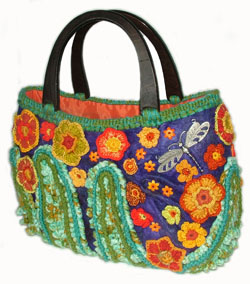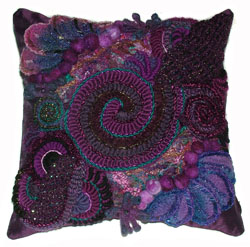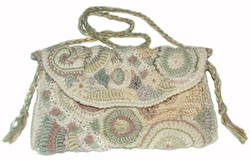Freeform Crochet Interview with Renate Kirkpatrick
By A Guest Writer – 10 CommentsA Guest Post by Linda Cee.
| I first heard about freeform crochet when I was exclaiming over a beautiful white shawl, I knew it looked complicated and like nothing I had previously seen, so I asked the lady who made it, what sort of pattern she used and she laughed and told me that she just made it up as she went, then she said she would be happy to show me how to make a scrumble. Well my first reaction was, huh? But then she explained that a scrumble usually starts with one piece, a circle, a square or anything else you would want and then you just start crocheting! You could make up stitches, add different colors and textures and use a variety of hooks to achieve whatever you can possibly imagine, I got incredibly excited when I saw a blue and purple scarf she had made that had beads, feathers, and thin gold ribbons crocheted right into it.
Some people compare freeform with sculpting because many freeformers make objects that are 2 or 3 dimensional and while some are very abstract, others are more realistic and recognizable, like a barn scene on a blanket for instance. Thanks to my current obsession with the craft, I found Renate Kirkpatrick’s Freeform Crochet~Knit~Fibre Designs which is a blog that is delightful to read and has a great introduction to freeform (with pictures!) I was very lucky to be able to interview Renate Kirkpatrick, who besides being a very gracious lady is also a teacher, fibre artist, and the author of three crochet books (with a fourth coming soon) and so without further ado here it is: |
  
|
How did you get started crocheting and when did you get interested in freeform?
I made my first granny square in my mid-teens from an old tattered ‘How to crochet’ pamphlet that I found in an opportunity shop.
In my late twenties when the children were in bed asleep I crocheted granny square rugs (afghans) for fun, relaxation and gifts but I soon became bored with the repetition and began searching for more interesting, challenging patterns. I had never read a pattern before, let alone decipher what the heck all those odd abbreviations meant but, I persevered and, over the years, through trial and error, gained confidence and experience.
Freeform was introduced to me by a student while teaching at a local craft shop and has become my passion and creative joy.
What are some tips that you find useful when crocheting? (Not necessarily freeform)
Read patterns as they are written – so many people (myself included) skim the pattern and presume what’s being said then race ahead only to find ourselves in a muddle – ‘The pattern is wrong…’ well, of course, that does happen sometimes but, more often than not, it’s because we haven’t read it properly.
Trust yourself – if you feel your project is going wrong, stop and have another look at the pattern, there’s a good chance you may have missed something… and isn’t it better to find the mistake on row 2 rather than on row 102?
Take the time to learn the basics – I have a ‘Do you know’ page on my site that covers most of these fundamentals that are often overlooked or taken for granted as ‘obviously known’ in patterns.
Use markers – just the odd piece of thread will do. I know it sounds old-fashioned and fuddy-duddy but, placing a marker in your first/last stitch of row/round, in corner stitches of blocks and for indicating right side of work, will save you lots of time and frustration in the long run… this is especially so for beginners.
Be patient and kind to yourself… it’s only crochet, the world will not end if you can’t figure it out straight away… put your project aside a minute, have a cuppa, take a breath and have another go…
Don’t give up. What seems impossible today might become super easy tomorrow and you’ll wonder what all the fuss and frustration was all about and your sense of achievement will be ever so rewarding.
When you began designing, did you have particular goals? Such as designing a certain type of sweater? Or being published?
For me designing and writing patterns evolved and really came about through the need to stay one step ahead of students and, satisfying the needs of family and friends… Not for a minute did I ever think about being published.
The books came about through tragedy when the store where I was teaching was destroyed by fire… fortunately I still had all my patterns which I put together into manuscripts and, on a whim, submitted (via the net) to publishers. Luckily, Sally Milner Publishing liked what they saw and contracted me for my first 2 books ‘Crochet Techniques’ and ‘Freeform Crochet and Beyond’ and have since published ‘Bring Colour to Crochet’ and the soon to be released 4th book ‘Textured Crochet Lace’.
You do many different types of crafts, including making pottery, rag rugs and paper; do you think these different types of creativity help to inspire your freeform?
I only ever dabbled with pottery. I never owned a wheel or kiln and, to be honest, didn’t go very far beyond hand building but I loved the textures and made some ‘not too bad’ pieces that still adorn my home today. The papermaking is another story… that became a full-time obsession for many years. Then, when I had to give up my workshop, I drifted into Rag Rugging and my love for colour was realized.
Do these past experience influence my freeform? Absolutely! I believe… the 3D textures and forms in pottery, the subtle delicate detail of natural fibre paper and the strong boldness of Rag Rugging are brought to my work whether I’m conscious of it or not but, then again, perhaps that’s more for others to decide.
Your books are full to the brim with useful and interesting ideas and helpful hints, how hard was it to come up with enough to fill even just one book?
I write everything down: questions from students, queries from my blog, my own questions… I then go looking for the answer and find the easiest way of explaining it.
Apart from ‘Freeform Crochet and Beyond’ my books are based on Sampler Rugs (afghans). The sampler is my teaching tool – the reader works their way through the various patterns gaining experience and confidence and end up with a lovely finished project as a bonus.
Some of my samplers have 25 blocks some as many as 64 blocks… it’s a lot of work, working out and writing the patterns and then, drawing the diagrams (charts) but, before you know it, you have enough for a book.
You often talk about color, how important is it to find just the right shades/tones for your work?
Colour came to me slowly… through the Rag Rugging mostly. I was timid at first but you only have to look at nature to see how the oddest colours sit side by side for the most dramatic effects. In my opinion, finding just the right colours is a matter of being brave, jumping right in and having a go…
Is there anything I haven’t asked you about that you would want to add?
As a teacher, there is nothing more satisfying than to have a student come to class lacking confidence and leaving excited, believing they can do it.
As a Freeformer, my best advice is to have a go… beautiful freeform can be created with the most basic skills… incorporate all the things you already know and comfortable with: the weaving, crochet, knitting, felting, quilting, embroidery… never stop asking yourself ‘ I wonder what will happen if I try this or that and, when a project overwhelms, becomes stale or just isn’t going in the direction you had envisaged… put it aside for an hour, a day, a month and come back to it with a fresh eye, you’ll be amazed how quickly your enthusiasm is restored.
Linda Cee is a young adult who enjoys many crafts including crochet, jewelry making, scrap booking and learning to tat. She also enjoys traveling and learning everything she can about history and foreign cultures.


thank you for this!!! I want to explore freeform this year… so many lovely items out there… I have a hard time letting that side of my brain come out and Play… One of those follow the pattern geeks… Love her advice about markers very important!!!!! have had to “frog” because of missing that end stitch or the correct corner chain… I have a made by me pincushion with coiless safety pins that in my notions bag.quick and easy…..will be following this. thanks to crochetblogger
Oooh! A notions pincushion sounds like a great idea 🙂
Rachel… I can certainly relate to you. I’m 78 and haven’t crocheted since I was 20 and then I just made vests. So I decided I need to learn to READ PATTERNS….so I did… and it was helpful but Inever got a completed “hat” (I’m starting with hats). So, one day I just gave up on the pattern instructions and made 90% of it “freestyle”. Well, my free style is not just “free creations”… it’s using the stitches that are the most fun for me and kind of easy… AND I use lots of DC’s so I can have that big hole for my next stitch which is often HDC (see, I did learn some stitches). So I can do the stitches that I need: do I need to make this hat smaller or bigger?????? AND I even learned the “stitch in back loop stitch”…. couldn’t manage without that so I incorporate an easy stitch just before it. Get the point. I have completed several pretty good hats with this method… I just tell people “I made it up myself”…but I like the term freestyle. Most of what I do in life is called “creative problem solving”… it comes natural with me. My brain has always been more dominant on the creative side… not that I am artistic…I just solve problems with my creative side of the brain. And from now on I will call my crocheted hats “freestyle”. Same goes for Afghans… I tried those too… no success and soooooo boring. I’m glad to know now that I am not just an old lady “stupid try to be crocheter”… I am a freestyler. Thank you so much for giving me the self confidence to go on with my new hobby.
me
P.S. from Carol. Well one thing my brain has not solved… how does a person make corrections in a “reply” to you. I had about 3 mistakes but cannot correct them. Sorry.
Hi Carol, there isn’t a way to edit something you already submitted. But you can reference your mistake or correct yourself by adding another comment. I’m not sure how to change the program to allow editing. I’ll have to look into it.
I am inspired by this interview;Renate’s enthusiasm is contagious! I want to start crocheting a freeform purse and it excites me to know that it will be as unique as I am.The interview also reminds me why I love crochet–because the creative possibilities are endless! Thanks for the inspiration,Linda
“Renate’s enthusiasm is contagious! ”
Yeah it is! I just had to start a project after talking to her 🙂
Good luck with your purse! I’ve yet to see a freeform purse that I didn’t like but I haven’t decided how I’d make one yet!
Ditto!!! I believe crochet to be one of the most creative crafts for that reason; the possibilities are endless! If you don’t think that you are creative (even though we all are in some way), you can always start with a basic pattern and alter it in some way. I never completed a freeform garment but certainly have it in the plans to do so!! Looks so enticing!!! For those out there that have not tried, be like me. Go on, take the plunge. Crochet and be free!!
Great interview! I think freeform crochet is just beautiful and am anxious to try it.
Thanks, hope you have fun with it 🙂